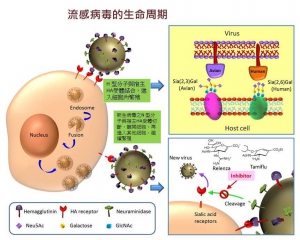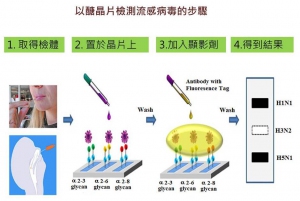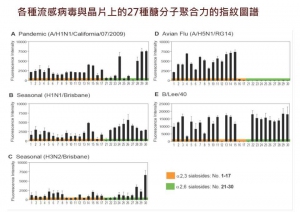The “Sugar Chip” team in Genomics Research Center at Academia Sinica has been devoted to the development of ingenious resolutions targeting glycan related issues. Led by Dr. Chung-Yi Wu and Dr. Chi-Huey Wong, the team has lately published two of their innovative approaches regarding sugar chip technology in “Journal of the American Chemical Society”. The same team had published its first solution for cancer detection back in 2008(See Prior Report). Now, it has moved on to the detection of influenza types, as well as selecting enzyme candidates for developing biomass energy.

Life Cycle of Influenza Virus
The fundamental mechanism of sugar chips is to design, make, and arrange various glycosylated molecules on a tiny glass chip, and then, by observing their binding with substance applied on the chip, one can find out the identity of the substance.
As globalization has changed the pace and scope of our lives, it is even more obvious that contagious diseases are travelling faster and farther as well. As SARS, H5N1 type avian flu, H1N1 Flu, and new antibiotic resistant germs appeared one after another one, it is inevitable that we need not only be able to cure, but also to have better and faster tools to prevent epidemics.

Experimental Procedures for Influenza Virus Detection
In a three years effort in designing a chip for diagnosing influenza, the team first obtained various types of the virus strains with help from the Center of Disease Control. With their specialized training in Glycoscience, they were able to design and synthesize glycans that bind the hemagglutinins molecules found on various influenza viral surfaces. As a result, they planted 17 such glycans that bind avian viruses and 10 that bind human viruses on the chip.
The research result shows, only in a matter of minutes, by applying the infected saliva on the chip, then read by a fluorescence reader, one could pinpoint clearly, if the viral infection is of type A, type B, or a new H1N1 type, or, a rare avian flu that usually only infect birds. So far, a so called “rapid test method” being used in the clinics, can only distinguish if the infection is type A, or, not type A.

Differential Binding Patterns of Different Influenza Viruses
“What’s scary about the influenza virus is that they are the RNA type virus, which means, when they mutate, there is no way to amend in nature’s way, so the mutation simply goes on and on”, explained Dr. Wu, ”however, with our sugar flu chip, we can establish a pattern for any new kind of flu in a rapid manner, thus, adequate measurement can be taken at the fastest time frame”.
When asked about the plan to transfer this technology into a product, Wu expressed that some biotech companies have expressed interest in the technology.
This research has been published online of the JACS website. Other contributors include Dr. Winston Chen, Dr. Ting-Jen Cheng, Dr. Jia-Tsrong Jan, Dr. Chien-Tai Ren, Dr. Chi-Hui Liang, and doctoral students Hsin-Yu Liao, and Che-Hsiung Hsu.
Another application of the sugar chip was published on JACS earlier as well, in which, the team not only made improvement of the chip material, they also demonstrated its usefulness by collaborating with a Biomass energy research team in Academia Sinica.
By using the glass chip, the transparent nature of the chip makes the handling more difficult. This entails a problem for quality control should it one day reach the production line. Therefore, the team came up with a way to coat a thin layer of aluminum oxide on the glass slide and attach a sugar covalently to the aluminum surface through a spacer group. When characterized by a mass spectrometer, the laser beam from the mass spectrometer will cleave the cleavable bond and release the sugar.
By working with the Biomass team to study its effectiveness in analyzing various cellulases activities, it proved this sugar chip approach can improve their efficiency dramatically.
Major participants of these projects besides Dr. Chung-Yi Wu, an Assistant Research Fellow of the Genomics Research Center, and Dr. Chi-Huey Wong, currently the president of Academia Sinica are: Dr. Andrew Wang, and postdoctoral fellows Dr. Susan Tseng, Dr. Jeng-Liang Han, Wen-Yih Jeng, and doctoral students Shih-Huang Chang, Hsin-Yu Lee, and Chin-Wei Lin.

